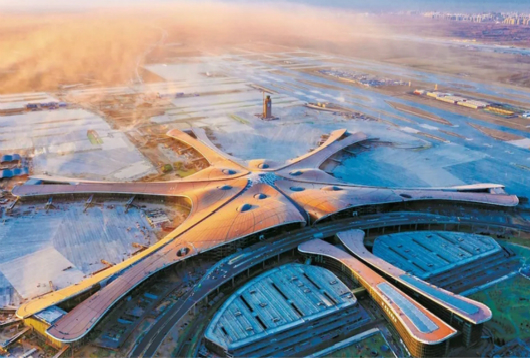
. > TOP STORIES
China transitioning to high-quality growth
Author : Wang Guanglu Source : Chinese Social Sciences Today 2019-10-25

Smart travel using 5G has been realized at Beijing Daxing International Airport, the world’s biggest airport, which began operations this September. Photo: BEIJING DAILY
Since the founding of the People’s Republic of China (PRC) in 1949, especially since reform and opening up, China’s achievements in economic and social development have attracted worldwide attention. Its economic structure has been continuously upgraded, the development has been more coordinated, and the economy and society have moved toward a high-quality development stage.
On the occasion of celebrating the 70th anniversary of the founding of the PRC, it is necessary to look back on the achievements and experience of China’s economic and social development and analyze what must be done to continue to optimize and upgrade its economic structure and to promote high-quality development.
Huang Kainan, vice president of Shandong University, Weihai, said that the PRC has witnessed enormous economic achievements in the past seven decades, especially since reform and opening up. China’s GDP has increased from 1.8% of the world’s total in 1978 to about 16% in 2018.In just a few decades, China has gone through the industrialization process that took Western industrialized countries more than 100 or even 200 years, entering a stage of post-industrial development, said Zhang Shourong, vice president of the Jiangsu Provincial Academy of Social Sciences.
Qiu Bin, a professor at Southeast University, tried to unlock the mystery of China’s economic growth. He said that the interconnection of transportation and communication has greatly promoted the flow of factors of production. Through opening up to the outside world and developing international trade, China’s economic growth has gained important momentum. The products made in China have good quality but medium-level prices, thus having a strong competitive advantage.
China pays attention to economic system innovation, promoting it on the basis of pilot zones. The free trade pilot zone is an important institutional innovation and is becoming an important platform for China’s opening up to the outside world in the new era, helping facilitate a comprehensive open economic structure.
In the past seven decades, a new pattern of coordinated development of the east, west, south and north of China is taking shape.
Since the founding of the PRC, China has implemented a series of national strategies and promoted regional coordinated development, such as the construction of the Third Front, the Western Development Strategy, Northeast China Revitalization, Beijing-Tianjin-Hebei coordinated development, the integration of the Yangtze River Delta region, and the construction of the Guangdong-Hong Kong-Macau Greater Bay Area. These strategies have achieved remarkable results, especially in promoting the coordinated development of east and west, cultivating and developing pivotal cities like Xi’an, Chengdu and Chongqing, and establishing a sound industrial system.
Taking Chongqing for instance, Huang said that during the construction of the Third Front, Chongqing achieved rapid industrialization and established a complete industrial system, becoming an industrial center after Shanghai and Tianjin. In recent years, in light of the Belt and Road initiative and the national strategy of the Yangtze River Economic Belt, Chongqing has turned the disadvantages of its geographical location into advantages, becoming the bridgehead for the opening up of Western China.
In addition, China’s urban and rural structure has been further optimized, and urban-rural integrated development has continued to advance. Jiang Changyun, a research fellow at the Institute of Industrial Economics and Technology Economics at China’s National Development and Reform Commission, pointed out that the migration of the population and the flow of resources and factors of production between urban and rural areas are increasing.
The continuous implementation of the rural vitalization strategy will better address the imbalance between urban and rural development and the inadequate development of agriculture, rural areas and rural residents, and it will establish a new pattern of urban-rural integration and development, Jiang said.
China is still the largest developing country in the world, and the problem of inadequate and imbalanced development is still prominent. It is necessary to promote the optimization and upgrading of the economic structure and continue to push the high-quality development of the economy and society.
To continue to promote the high-quality development of the economy and society, it is necessary to focus on the real economy dominated by manufacturing, said Zhang Jie, a professor from the Institute of China’s Economic Reform and Development at Renmin University of China. In terms of policy measures, Zhang suggested implementing differential and structural tax cuts for different sectors, businesses and industries.
Talent is the most important resource, Zhang continued. It is necessary to cultivate more senior technicians, engineers and R&D personnel needed for the high-quality development of the manufacturing industry.
In addition, Zhang said that it is necessary to deepen the reform of the financial system and promote the transformation from indirect financing to direct financing, in order to meet the long-term and sustainable development needs of the real economy.
Zhang said that it is necessary to strengthen innovation policies, promote the endogenous growth of the economy, establish competition policies to optimize the market environment, build mechanisms to boost regional coordinated development, and improve the ecological and environmental protection system to facilitate green and sustainable economic development.
Huang proposed to increase basic R&D expenditures and strengthen innovation-driven development. We must value and promote innovations with world-class, original basic research and promote high-quality economic development.
Ye Shengtao made Chinese fairy tales from a wilderness
Ye Shengtao (1894–1988) created the first collection of fairy tales in the history of Chinese children’s literature...
-
How northern ethnicities integrated into Chinese nation
2023-09-18
-
Mogao caves
2023-09-12
-
Mogao Grottoes as ‘a place of pilgrimage’
2023-09-12
-
Time-honored architectural traditions in China
2023-08-29
-
Disentangling the civilizational evolution of China
2023-08-28
-
AI ethics in science fiction
2023-08-23













 2011-2013 by www.cssn.cn. All Rights Reserved
2011-2013 by www.cssn.cn. All Rights Reserved